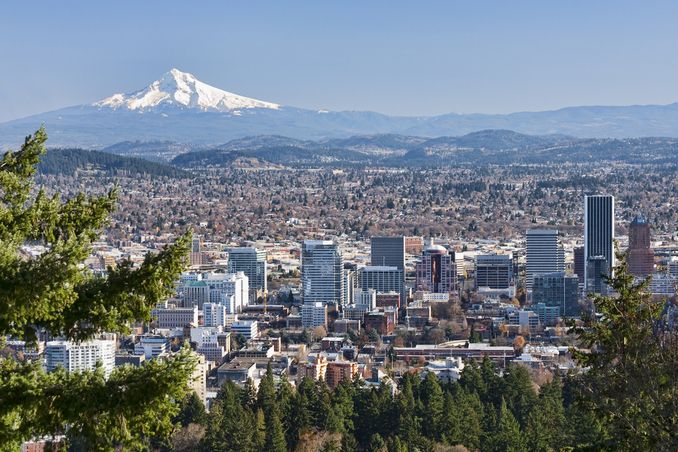Addiction Treatment Centers in Oregon
Oregon is famed for its stunning Pacific coastline to the east and mountain region to the west, including the most prominent peak, Mt. Hood. It is bordered by California to the south and Washington to the north. Oregon, perhaps because of its natural beauty, periodically hosts film shoots, with hundreds of films either entirely or partially shot there. Oregon alcohol and drug rehab centers may not feature in many film events, but they play a key part in helping those suffering in the state get the help they need.
Unfortunately, as in many other states, drug and alcohol abuse pose a threat to the state of Oregon, particularly the state capital of Portland. In addition to its internal use, Oregon is a key hub for drug shipments to Washington and Canada. Methamphetamine and heroin use are the most serious drug issues in Oregon, but club drugs like ecstasy, diverted prescription medicines, and marijuana are all widely available.

Twelve percent of adults in Oregon suffer from some form of substance abuse. This is huge in comparison to the national average of about eight percent. Although you may not expect this from Oregon, it holds some of the highest substance abuse rates in the country. This is a cause for concern, as the rate of prescription medication abuse rises and the need increases for Oregon alcohol and drug rehab centers.
Fortunately, the number of treatment centers is also rising in Oregon. This is because, in 2010, 46,629 people went into treatment for drug and alcohol abuse. With prescription painkillers and heroin being the largest threats in the state, treatment centers amped up their programs and are providing incredible facilities. At Find Addiction Rehabs, we can help connect with you to the leading Oregon drug rehab and alcohol rehab centers.
Drug and Alcohol Treatment in Oregon: The Basics
Choosing a treatment program in Oregon can be difficult, but there are a few specific needs you should have met.
- Treatment should be easily accessible: This means you should not need to wait a long time to get into a program. Time is of the essence with drug and alcohol treatment. Private treatment should be able to ensure a more prompt entry to the program.
- Care should be personalized: No addiction is the same, meaning there should never be a one-size-fits-all approach to recovery. You deserve your own individualized and tailored treatment program that fits your situation.
- Medical treatment should always be provided: Whether you need medical care for your ongoing disorder or an individual case, it should be readily available.
- Treatment should be based on research: All treatments must be evidence-based. Although alternative treatments can be used to complement care, the basis of treatment should always be a medical detox or comprehensive therapy.
- Social support should be provided: You should never be cut off from family and friends. Although you should not be allowed to participate in activities that may trigger you, treatment should involve peer support in group therapy and support group meetings. You should also be provided an aftercare plan that includes opportunities to build and strengthen your support network.
- Treatment should be ongoing: The duration of your treatment is critical to its success. You should participate in therapy for at least 90 days to ensure the best chances of sustained recovery. Despite this, some programs start at 28 days for those who are not dealing with as severe a disorder.
Oregon Rehabs and Drug and Alcohol Addiction Statistics
Over 1.1 million Oregonians – 26.37 percent of the state population – use drugs each year, with another 262,000 – 6.25 percent of the state population – abusing alcohol. As a result, drugs and alcohol were responsible for 21.34 percent of all deaths in Oregon between 2008 and 2017, which is about nine percentage points higher than the national average of 12.71 percent.
Eugene had the greatest rate of such deaths over the same period (22.22 percent) among Oregon’s three most populated cities, followed by Portland-Gresham with a rate of 22.11 percent. Salem, Oregon’s capital, had the lowest overall number of deaths as well as the lowest alcohol- and drug-related death rate percentage of 20.75 percent.
This resource was created to assist the many Oregon citizens battling with substance misuse and addiction in locating addiction treatment that will put them on the road to recovery. It is also designed to educate the general population about the hazards of substance abuse.
- In 2010, 46,629 persons in Oregon attended drug and alcohol rehabs, according to the Treatment Episode Data Set (TEDS).
- Oregon has continuously rated among the top ten states in numerous measures of alcohol and other substance use and abuse in two age groups: age 12 and older as well as age 26 and above.
- The number of drug and alcohol treatment centers has decreased somewhat between 2002 and 2006, from 232 to the current 224, according to the National Survey of Substance Abuse Treatment Services (N-SSATS).
- There has been a consistent drop in the number of admissions mentioning alcohol or cocaine as an abused substance during the last 13 years, with concurrent increases in the mentions of marijuana and heroin.
- In 2007-2008, Oregon scored top among all states in various drug categories, including past-month use of illicit drugs other than marijuana among those aged 12-17, past-year nonmedical use of pain medicines among those aged 18-25, and past-month illicit drug usage among those aged 26 and older.
- Approximately 12% of Oregon residents reported using illicit substances in the previous month, compared to 8% nationally.
Prescription Drug Abuse in Oregon
Since 1999, Oregon has been one of the states most hit by prescription medication misuse. In 2013, one-quarter of Oregon citizens were prescribed opioid pain relievers. The Beaver State placed second in the nation in prescription drug addiction rates the same year.
The state-recognized doctors’ overprescription of opioids is a significant contributor to the problem. Oregon doctors wrote prescriptions for 11.6 kg of morphine-equivalent drugs per 100,000 persons, about twice the rate of states with lower prescription rates.
Substance Abuse Treatment for Oregon Veterans
The Oregon Veterans Behavioral Health Services Improvement Study, published by the Oregon Health Authority, found that the opioid-related death rate for veterans in the state surpassed the rate for non-veterans between 2013 and 2017. The most notable difference occurred in 2017, when the opioid-related death rate among veterans was 11.4 percent, compared to 8.3 percent among non-veterans.
Veterans in Oregon can contact their local VA medical center to learn more about drug abuse treatment options, including the possibility of a VA-based substance use disorder (SUD) program in their state. They can also get crisis help and referrals to substance addiction treatment services through the Military Helpline via Lines for Life.
As part of the Returning Veterans Project, free and confidential substance addiction therapy and other services are also available at locations around the state. However, these services are only available to post-9/11 war veterans, active serving service personnel, and their families.
Treatment options are offered in Oregon for veterans suffering from a substance use disorder. As of 2017, 37 substance addiction treatment clinics in Oregon catered particularly to veterans, accounting for 16.4 percent of all treatment centers.
Substance Abuse Treatment for Adolescents in Oregon
Between 2017 and 2018, 9.7 percent of teenagers aged 12-17 in Oregon reported using marijuana in the previous month, more than three percentage points more than the national average of 6.6 percent. In terms of alcohol consumption, 10.6 percent of teenagers aged 12-17 in Oregon had done so in the previous month, which is higher than the national average of 9.4 percent. Some treatment centers offer adolescent-specific treatment programs to help youngsters overcome the hurdles of overcoming chemical addiction.
What can I Expect from Oregon Drug Rehabs?
Drug rehabilitation is the process of medical or psychological treatment for addiction to psychoactive substances such as alcohol, prescription medications, and street drugs such as cannabis, cocaine, heroin, or amphetamines. The main goal is for the patient to be able to confront substance dependence if it exists and stop abusing substances to avoid the psychological, social, legal, financial, and physical issues that can arise.
Treatment includes medication for depression or other disorders, skillful therapy, and sharing of experiences with other addicts.
Rehabilitation Centers in Oregon
If you are looking for a short-term residential treatment center in Oregon, there are over twenty-five options available, with many of them located in the cities of Portland and Eugene. With ‘alcohol rehab Portland Oregon’ being a highly sought-after search topic, the need for Portland alcohol addiction treatment centers is clear.
Though, with facilities around the state, a person can expect to obtain help quickly and at least have a chance to conquer their drug or alcohol addiction in Oregon. When things continue to become overwhelming and worse, you should seek help as soon as possible, because it could life-saving.
Substance Abuse Treatment Centers in Oregon
Addressing the underlying causes and reasons for addiction is always a part of the therapy process for any addict. The reason you would go to a short-term drug rehab center in Oregon, on the other hand, would be to get away from temptation. Cravings can be triggered by a variety of factors, including physical or psychological factors, as well as the situation in which you find yourself.
When you go to a short-term drug rehab program, you eliminate temptation and are surrounded by encouraging people and other sober people working towards the same goal. It is critical to be in a setting where drugs and alcohol are just not an option.
Short-term treatment centers can assist you with this. Although the programs are not long-term, you can still have every opportunity to address all aspects of your addiction. If you believe that the length of time you have in a short-term program is insufficient, you have other possibilities.
Aftercare treatment is not uncommon for those who have completed a short-term drug rehab program. This could be a beneficial transition period, for example, in a sober living home.

Getting additional clean time under your belt is vital and will only help you stay sober. It would be absurd to believe that once you finish therapy, you will never face temptation again. However, if you are well-equipped and have the means to face problems, maintaining your sobriety becomes a lot easier. Short-term drug rehab facilities in Oregon might be a fantastic place to start your journey.
Unfortunately, substance misuse affects a wide range of counties across the state. Between 2012 and 2016, Baker County, for example, experienced 20 drug-related deaths. During that period, the yearly drug deaths per 100,000 population were 24.8, which was slightly higher than the state average.
During those years, the poverty rate in Baker County was roughly 15%, which may have contributed to people choosing to abuse drugs or alcohol. It is all too simple to turn to illegal substances to help you deal with your difficulties. It does provide a momentary escape from reality, but drugs increase bad emotions and produce more problems in your life. It will be critical to find the correct form of short-term treatment.
Exploring Rehabilitation Centers in Oregon
Addiction therapy is accessible at many levels and as part of a continuum of care. This means that no matter where you are in your recovery, you can find help for your substance use disorder.
To fulfill the needs of its inhabitants, Oregon provides a variety of substance abuse and mental health treatment options. Private for-profit and non-profit facilities, as well as municipal government-owned facilities, are the most popular forms of treatment programs in Oregon.
Medication-assisted therapy for opioid addiction, such as methadone and buprenorphine, is available at some Oregon treatment centers.
Peer support groups and family involvement are common features of addiction therapy in Oregon. The state also provides money to persons in need of treatment who are either uninsured or do not have appropriate coverage to help with the cost of addiction treatment.
For citizens who do not have health insurance or cannot afford therapy, about half of the state’s medical facilities offer sliding scale pricing or free treatment. Treatment options range from detox to aftercare therapies.
Medical Drug & Alcohol Detox in Rehab in Oregon
Detoxification is one of the most important aspects of recovery. This level of care provides medical assistance while you are in withdrawal.
It starts with an assessment of your withdrawal symptoms and then moves on to help you while your body heals.
Residential/Inpatient Drug Rehab
Residential therapy gives you 24-hour access to medical and therapeutic staff who can assist you during difficult times in your recovery.
Peer assistance is usually incorporated into the treatment regimens of inpatient programs. Residential programs may also provide psychiatric care for people who have co-occurring illnesses or who have both addiction and mental health issues.
Outpatient Addiction Treatment
A partial hospitalization program will provide practically all of the same treatments as a residential program. However, to keep your appointments, you must travel to the treatment center.
An intense outpatient program (IOP) is another outpatient alternative in which you receive at least nine hours of treatment services each week, which may include group therapy, wellness programs, counseling, and other services.
Medication-Assisted Treatment
This sort of treatment, also known as MAT, employs drugs to assist those suffering from opioid or alcohol addiction. Methadone is one example of a well-known MAT medicine.
Medication does not substitute one chemical for another. Rather, they address the underlying psychological and physical symptoms of some of the most severe forms of addiction. Medications are almost certainly used in conjunction with behavioral treatment, peer support, and other recovery services.
Aftercare Support
Addiction is a long-term medical disease. This means that even when the primary therapies are done, a recurrence is possible. Long-term aftercare programs can aid you for years after you leave your treatment program.
What is the Cost of Rehab in Oregon?
Although the cost of addiction treatment varies, many Oregon rehab centers take health insurance. If you have health insurance, your provider can inform you what services are covered and whether you should go to an in-network institution.
Certain addiction treatment therapies are covered by both Medicare and Oregon’s Medicaid program. If you don’t have insurance or if the rehab you’re interested in doesn’t accept insurance, there are low-interest healthcare loans available to assist you to pay for treatment on a budget-friendly schedule.
Certain institutions may provide sliding scale rates based on your ability to pay; therefore, it is critical to call and inquire about the fees and payment plans.
Using Insurance for Addiction Treatment in Oregon
In Oregon, it is simple to use your insurance to pay for addiction treatment. Depending on your insurance, you may be able to have it pay all, or part of your addiction treatment fees.
You can use these methods to identify how much your insurance can assist you with.:
- Contact the number on the back of your insurance card and inquire about the various treatment options that are covered.
- Call a treatment provider directly whether they can authenticate your insurance.
- Check your insurance policy to determine if addiction treatment is an option.
- Comprehend the fundamentals of coverage, including in-network providers, co-pays, and deductibles, as well as how these elements may affect your out-of-pocket expenditures
If You Don’t Have Insurance for Treatment Centers in Oregon
Oregon residents have access to state-funded treatment choices. These are receiving increased money as a result of new legislation, although they are often in high demand.
The state also provides the Oregon Health Plan to low-income individuals and families to help them gain access to medical care, including addiction treatment.
Mental Health Resources & Treatment
If you or someone you care about is suffering from a mental health problem, such as PTSD, depression, eating disorders, or severe anxiety, there are numerous options available to assist you.
According to MentalHealth.gov, there are a few methods to get immediate help:
Emergency Services: If your life (or the life of someone else) is in danger, always contact 911 to receive rapid access to emergency services.
Suicide Prevention: The National Suicide Prevention Lifeline number is 800-273-8255. You can also start a private online live conversation, or an SMS chat by texting 838255
Here are two methods for locating a mental health care provider in Oregon:
Oregon National Alliance on Mental Illness (NAMI): The Oregon branch of NAMI provides information on mental health resources around the state, as well as sections on programs for teenagers and veterans’ families.
Oregon Health Authority: This website has a searchable directory of community mental health programs that give treatment to people suffering from mental illness, substance misuse, or gambling problems.
Individuals suffering from both substance abuse and mental health issues may benefit from dual-diagnosis treatment centers. Using the proper filter in our tool above, you can identify rehabilitation centers with treatment programs tailored to the unique challenges offered by co-occurring substance use and mental health disorders.
Oregon Is a Great Place to Be Sober
Oregon, tucked away in the scenic Pacific Northwest, is one of the country’s often-overlooked treasures. This diversified state, with its jagged coastlines and pure evergreen wilderness, has no shortage of magnificent landscapes that have become interwoven into recovery programs.
Wilderness counseling, often known as outdoor or adventure therapy, functions similarly to standard programs. Outdoor therapy, like traditional counseling, tries to help clients heal and overcome obstacles in their lives. Unlike traditional treatment, however, the sessions take place outside. They could also include services like hiking therapy.
The Benefits of Adventure and Wilderness Drug Therapy Programs
Patients can learn more about who they are as individuals and think beyond themselves for the welfare of others by participating in engaging adventure therapy activities and volunteer work.
Clients can focus on their personal growth and the improvement of vital life skills while they are removed from technology and anything else that may have been a difficulty for them back home. Clients acquire confidence and a sense of empowerment via tailored therapeutic work with staff and adventure therapy activities that they would struggle to gain in their home context. Such kinds of adventure therapy activities and standard therapeutic procedures ultimately aid in the promotion of long-term recovery.
Should You Travel to a Treatment Center in Oregon?
Addiction Treatment Laws in Oregon
Harm reduction legislation seeks to safeguard Oregon residents from the negative consequences of substance usage. Each law tackles the impact of addiction and includes measures for prevention, treatment, and sober maintenance. Oregon’s harm reduction legislation has helped to reduce the number of drug overdoses and the transmission of infections during the last several decades.
M110 and Decriminalization of Drugs in Oregon
With the passage of Measure 100, the state of Oregon remains the first in the United States that has made access to treatment and not law enforcement the natural recourse for those caught with illegal substances in amounts consistent with personal use. While the launch of this measure has improved access to behavioral health measures and drew its inspiration from the policies that generated such success in Portugal, the overall efficiency and effects of M110 have been complicated by the presence of Covid and political instability in the state.
The promise of treating those with substance use disorders more compassionately remains, and the experiment in the state of Oregon has the potential to help form more humane (and effective) policies across the country.
Syringe Exchange Program (SEP)
Oregon was the first state to provide syringe access as a public health intervention in 1987. In many ways, the state has taken its cues from Canada and other countries with a more progressive approach towards addiction. The state legislature approved legislation that year to exclude syringes from the definition of paraphernalia. Clean needles are available in pharmacies, retail stores, syringe exchange programs (SEPs), and, in some cases, vending machines.
Oregon hopes to prevent needle-sharing among drug users by providing access to clean, sterile syringes. This will aid in the prevention of infections such as HIV/AIDS and hepatitis. Local organizations frequently collaborate with SEPs to assist persons seeking to overcome an addiction. Low-cost treatment programs, support groups, inexpensive housing, and career workforce options are examples of services.
Oregon High-Intensity Drug Trafficking Area (HIDTA) Program
The Oregon High-Intensity Drug Trafficking Area (HIDTA) program focuses on statewide drug trafficking initiatives. It consists of eight federal agencies, three state agencies, 40 local agencies, and the United States Attorney’s Office for the District of Oregon.
These groups collaborate to combat drug trafficking by utilizing cutting-edge equipment and other technological resources. Programs share the following objectives:
- Taking on money-laundering organizations.
- Reducing the availability of pharmaceuticals.
- Identifying and dismantling drug trafficking networks
Intensive Treatment and Recovery Services (ITRS) Program
The Intensive Treatment and Recovery Services (ITRS) initiative in Oregon started in 2007. Through regular and rigorous outpatient treatment, case management, and peer mentorship, the state program keeps parents and dependent children together. It also contributes to the availability of sober housing for families and pregnant women.
Approximately 93 percent of parents who finish Oregon’s Intensive Treatment and Recovery Services program meet the State’s criteria for regaining the custody of their child or children.
ITRS enables parents to seek addiction treatment and begin a new life for their families. The program’s services lead individuals on the path to long-term recovery and assist them in being the best parents they can be for their children.
Treatment Centers In Oregon
Every year, roughly 50,000 Oregonians seek addiction treatment. Oregon has some of the highest rates of people checking into residential treatment centers for intense therapy.
The Oregon Health Authority is anticipated to spend $51 million per year on substance misuse treatment. This money is used to fund rehab centers, support groups, counseling programs, and other initiatives that aid in the fight against addiction.
Oregon’s Medicaid program began covering addiction treatment treatments such as:
- Outpatient rehab
- Medication-assisted therapy in the mid-1990s.
- Hospital-based detoxification
- Residency therapy
Many of Oregon’s treatment centers, like those in other states, have waiting lists. However, the state has several programs and support groups in place to keep people from reverting to old behaviors. Some community organizations in Portland, for example, provide free food and clothing to persons who are homeless and battling with addiction. It is effective in getting people the assistance they require to overcome a substance abuse issue once and for all.
When looking for treatment programs, make sure to include both in-state and out-of-state facilities in your search. Sometimes the best place to recover is a long distance away. Out-of-state programs have several advantages, including:
- Personalized therapy and activities
- Amenities tailored to your preferences.
- Cutting-edge treatment equipment.
- Increased distance from potential triggers and negative influences.
A closer look at State and local programs unique to Oregon:
- Oregon Health Authority: The OHA provides information about addiction and mental health services, such as how to get help in a crisis, where to find treatment, and resources for individuals, children, and families dealing with addiction or mental health difficulties. The OHA website also contains information on minimizing opioid overdose and misuse, such as the hazards of opioids, indicators of an overdose, and how to use Narcan to reverse the effects of an overdose (naloxone).
- Portland Police Bureau. The Portland Police Bureau’s Behavioral Health Unit provides a list of treatment programs for veterans, adolescents, adults, and the elderly. Local crisis intervention services, culturally competent treatment programs, low-cost housing choices, and resources for family members are also included in the list.
- National Alliance on Mental Illness: NAMI Oregon educates and supports those affected by mental illness and their families. The charity offers face-to-face support groups as well as online courses in English and Spanish, with the goal of decreasing stigma and assisting persons impacted by mental illness in their recovery.
Oregon Marijuana Legalization
Beginning July 1, 2015, Oregon legalized the recreational use and possession of small amounts of marijuana for people aged 21 and up. Residents may have up to four plants in their house, eight ounces of usable marijuana in their home, and one ounce on their person. Beginning October 1, 2015, recreational marijuana could be purchased from existing medical marijuana clinics, and retail stores were anticipated to open in the second part of 2016.
It is, nevertheless, unlawful to consume marijuana in public, even in establishments with a state liquor license. It is also prohibited to transport marijuana across state lines, including the Washington state line. It is also prohibited to drive a car while under the influence of marijuana.
Oregon Measure 110, Drug Decriminalization and Addiction Treatment Initiative (2020)
Measure 110, or the Drug Addiction Treatment and Recovery Act, was approved by Oregon voters in a referendum in November 2020. This law reduced personal non-commercial possession of a controlled substance to a Class E offense (with a maximum fine of $100) and established a drug addiction treatment and recovery program supported in part by marijuana tax income and state jail savings.
Oregon’s new law decriminalizing possession of small amounts of all narcotics for personal use went into effect earlier this year and has been praised as a “revolutionary” step in the right direction by drug policy reform supporters.
When they approved the ballot issue, Oregonians acknowledged that drug addiction and overdoses are a severe problem in the state and that Oregon needed to improve access to drug treatment. A medical response to addiction and overdose is more effective, humanitarian, and cost-efficient than criminal penalties. Making people criminals because they are addicted is costly, damages lives, and can make treatment and recovery more difficult.
Possession of illegal substances is now a civil violation punishable by a fine and court-ordered therapy rather than a criminal one punishable by jail time. Using a public health approach that provides treatment rather than the decades-long war on drugs approach that results in jail is one that Oregon now shares with countries such as Portugal, the Netherlands, and Switzerland, among others.
Criminal punishment has been demonstrated to have little to no effect on reducing crime, including illegal drug usage and possession.
How Long Does Recovering from Drug and Alcohol Addiction Take?
The length of time it takes to recover from drug or alcohol dependence is determined by a variety of factors. It all starts with the individual, the type of addiction he or she has, and the severity of the dependency. Some medications may only necessitate outpatient care, allowing you to treat yourself at home. Others necessitate an inpatient stay in a residential treatment facility.
Oregon rehab facilities, like those in California and the majority of other states, provide anything from short-term, one-month solutions to 120-day and even longer-term options. Speak with an expert to learn more about locating a treatment clinic in Oregon for you or a loved one.
Get Help to Change Your Life, Here!
Alcoholism and drug addiction are two of the most difficult issues to overcome. It requires assistance. Fortunately, Oregon has recovery centers located around the state for those interested in overcoming their addiction.
Addiction, according to today’s mental health professionals, is not an issue caused by poor morality or a lack of self-control. It is an emotional and physical disorder that frequently co-occurs with mental health issues such as depression, trauma, and stress.
All of these aspects are considered in the most effective treatment, which is tailored to each individual and their specific difficulties. Addiction therapy is the first step on the road to recovery, and many rehab centers in Oregon will assist you in getting back on your feet. If you don’t know where to begin, feel free to contact Find Addiction Rehabs‘ professional team of navigators to guide you in finding a suitable treatment facility.




